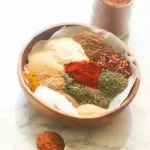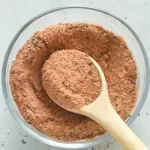Seasoning is the process of supplementing food via herbs, spices, salts, and/or sugar, intended to enhance a particular flavour. In the culinary arts, the word spice refers to any dried part of a plant, other than the leaves, used for seasoning and flavouring food, but not used as the main ingredient.
- Steak Seasoning Mix
- Blackened Seasoning Mix
- Creole Cajun Seasoning Mix
- Taco Seasoning Mix
- Italian Seasoning Mix
Seasoning Fun Facts
The green leafy parts of plants used for seasoning and flavoring food are considered herbs.
Spices are usually used dried, though some, such as chili peppers and ginger, are used in both their fresh and dried forms.
Many spices have antimicrobial properties, which may explain why spices are more prominent in cuisines originating in warmer climates, where food spoilage is more likely, and why the use of spices is more common with meat, which is particularly susceptible to spoiling.
More Interesting Information About Seasonings
The first recorded use of spice dates back to 3000 BC in ancient Sumeria.
In Sumeria, people used spices such as cumin, coriander, and turmeric to flavor their food. These spices were also used for medicinal purposes like treating colds and digestive issues. Back then, people believed that spices had magical powers and could even be used to ward off evil spirits.
The ancient Egyptians were the first to cultivate and use garlic.
The Egyptians believed that garlic had magical properties and used it to protect against evil spirits. Garlic was also used as a medicinal herb to treat a variety of ailments. Some modern folk tends to believe that garlic can ward off vampires!
The ancient Greeks used cinnamon to flavour their wine.
Cinnamon was also used in the embalming process. The Greeks believed that it had the power to preserve the body and soul from corruption.
In the Middle Ages, pepper was so valuable that it was often used as currency.
Pepper was so valuable that it was even used to pay rent. A pound of pepper could cost as much as a sheep or a cow. A pepper-crusted steak had a different meaning back then! Today, pepper is grown in tropical countries and is one of the most common spices used in cooking.
The Egyptians were the first to cultivate and harvest spices on a large scale.
- Agriculture in ancient Egypt was highly developed, and spices were one of the main crops.
- Salt was used to preserve food before refrigeration was invented.
- The Egyptians were the first to use salt as a preservative.
- The Egyptians exported spices to other countries in Africa, Asia, and Europe.
- The Egyptians also used salt in their mummification process.
- This allowed the Egyptians to trade with other countries for their spices and other goods.
- The spice that was farmed included cinnamon, pepper, ginger, and turmeric.
The Romans were the first to use nutmeg as a spice.
The Romans used nutmeg to flavour their food and also believed that it had medicinal properties. Nutmeg was used to treat a variety of ailments, including indigestion, headaches, and even the plague.
Unfortunately, the plague wasn’t something that could be cured with a sprinkle of nutmeg!
The first recorded use of ginger dates back to China in the 3rd century BC.
Ginger was used in Chinese cuisine and also had medicinal purposes. It was used to treat nausea, colds, and stomach problems. Today, ginger is used in many cuisines all over the world and also to treat nausea and indigestion.
In the 13th century, Marco Polo brought spices back to Europe from his travels to Asia.
Marco Polo was the first European to travel to Asia and bring back spices. He introduced Europeans to a variety of new spices, including ginger, cinnamon, and pepper. The globalization of the spice trade had begun.
In the 15th century, Christopher Columbus sailed to the Americas in search of a new route to Asia.
The Age of Exploration was a time when Europeans sailed to new lands in search of trade routes. While he didn’t find a new route to Asia, he did discover a wealth of new spices, including chili peppers, allspice, and vanilla. As a result, establishing trade routes with India, Africa, and the Americas.
Today, we enjoy spices from all over the world in our cooking.
The globalization of the spice trade has resulted in a wide variety of spices being available to us today. We can thank Marco Polo, Christopher Columbus, and other explorers for bringing these delicious spices to our tables.






